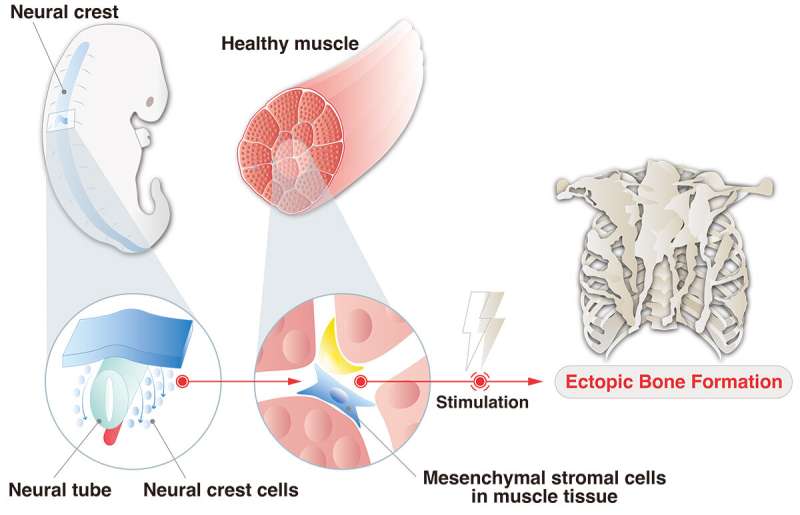This article has been reviewed according to Science X's editorial process and policies. Editors have highlighted the following attributes while ensuring the content's credibility:
fact-checked
trusted source
proofread
Unveiling the origins of ectopic bones: Insights from neural crest cell research

The research group led by Dr. Chengzhu Zhao (now Associate Professor in Chongqing Medical University) and Associate Professor Makoto Ikeya has discovered that ectopic bones formed in abnormal locations originate from neural crest cells. This study provides new insights into our understanding of bone disorders.
To accurately study pathological conditions using cultured cells, it is crucial to use cells that either cause the disease or closely resemble the disease-causing cells. Induced pluripotent stem cells (iPSCs) can differentiate into various cell types, thus making them an ideal tool for modeling diseases. However, to effectively utilize iPSCs, it is critical to understand how disease-causing cells are formed during embryonic development.
Ectopic ossification is a condition characterized by the formation of bone in tissues where it does not normally occur. It can result from trauma or surgery but can also be caused by genetic mutations in some cases, such as in fibrodysplasia ossificans progressiva (FOP), a rare genetic disorder. Previous murine studies have shown that ectopic bones originate from mesenchymal stromal cells in muscle tissues rather than muscle cells themselves. However, the specific origin of these mesenchymal stromal cells remained unknown.
The research group has now discovered these mesenchymal stromal cells to originate from neural crest cells, which are transient cells that appear during embryonic development. This finding provides a crucial scientific basis for detailed studies on ectopic bone formation. By understanding the cellular origins of ectopic bones, researchers can utilize iPSCs to generate mesenchymal stromal cells via neural crest cells, enabling more accurate and effective studies on ectopic bone formation. The results of the study were published online in Genes & Diseases on May 29, 2023.
Moreover, the implications of this research extend beyond ectopic ossification. Mesenchymal stromal cells in muscle tissues play a vital role in muscle homeostasis and regeneration. Therefore, the findings of this study not only contribute to the understanding of ectopic bone formation but also have the potential to aid in developing novel therapeutic approaches for skeletal muscle-related disorders caused by mesenchymal stromal cells.
In conclusion, the study highlights the significance of neural crest cells in ectopic bone formation and validates the use of iPSC-derived mesenchymal stromal cells to study this pathophysiologic process. This research opens the door for further investigations and may ultimately lead to the development of new treatments for various bone and muscle-related disorders related to mesenchymal stromal cells.
More information: Chengzhu Zhao et al, Myelin protein zero (P0)- and Wnt1-Cre marked muscle resident neural crest-derived mesenchymal progenitor cells give rise to heterotopic ossification in mouse models, Genes & Diseases (2022). DOI: 10.1016/j.gendis.2022.09.002





















